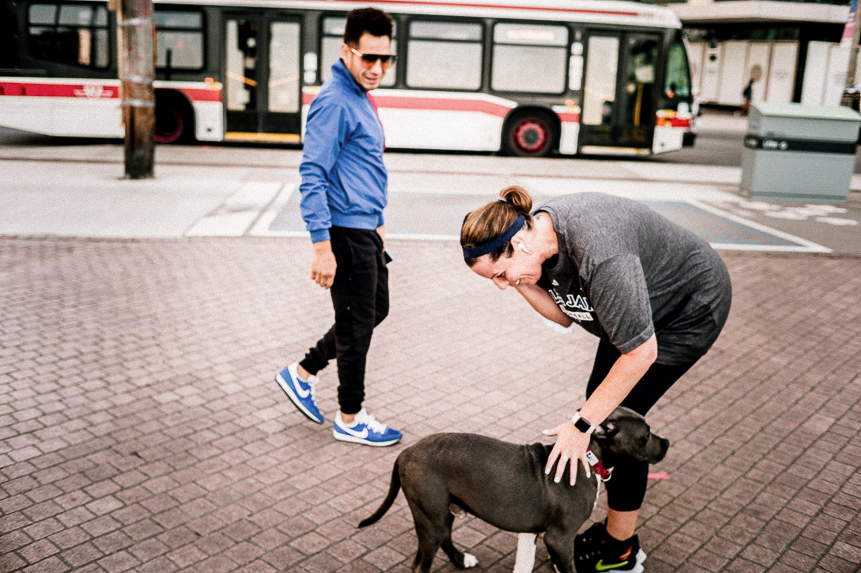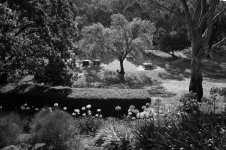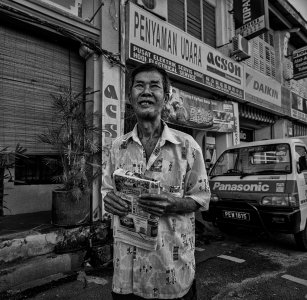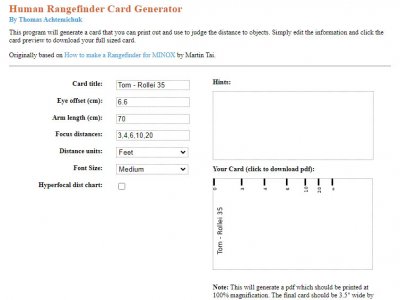Bill N
Member
What have you figured out over time? Or from reading?
Ko.Fe.
Lenses 35/21 Gears 46/20
Two levels.
Beginner. Those are using DOF and focus scales. By looking at them. You know, "f8 and be where".
Advanced. We are using focus tab. Often without looking at those scales at all.
Beginner. Those are using DOF and focus scales. By looking at them. You know, "f8 and be where".
Advanced. We are using focus tab. Often without looking at those scales at all.
agentlossing
Well-known
Many lenses with focus tabs position the "zero" point where the tab is facing straight down from the lens in a very useful zone, EG 2 meters. I believe that's where my Voigt 35/2.5 Skopar LTM focus stud ends up.
I zone focus a lot with film (which is my main "street" process, film cameras look more disarming) and find that the grain with B&W film processed with rodinal hides slight focus inconsistencies quite well. I haven't yet figured out how to make digital look so indifferent to the exact DoF "slice" but am still seeking it.
I zone focus a lot with film (which is my main "street" process, film cameras look more disarming) and find that the grain with B&W film processed with rodinal hides slight focus inconsistencies quite well. I haven't yet figured out how to make digital look so indifferent to the exact DoF "slice" but am still seeking it.
Retro-Grouch
Mentor
DOF scales are an approximation. I always err on the side of caution and use the scale for the aperture that is one stop larger than the one in actual use. Also, DOF scales on many FSU lenses sometimes have no connection with reality when compared to the scales of comparable focal length lenses from Japanese or German manufacturers. When they differ, they are usually far too generous.
Ko.Fe.
Lenses 35/21 Gears 46/20
DOF scales are an approximation. I always err on the side of caution and use the scale for the aperture that is one stop larger than the one in actual use. Also, DOF scales on many FSU lenses sometimes have no connection with reality when compared to the scales of comparable focal length lenses from Japanese or German manufacturers. When they differ, they are usually far too generous.
I use DOF scale as approximation for sure. Nor I could tell exact distance.
It also helps to learn DOF and focus distance with on-line DOF calculator (but it is kind of broken partially now).
No difference between Leitz, CV and FSU 50, 35 and 28 mm in this regard.
Ko.Fe.
Lenses 35/21 Gears 46/20
Many lenses with focus tabs position the "zero" point where the tab is facing straight down from the lens in a very useful zone, EG 2 meters. I believe that's where my Voigt 35/2.5 Skopar LTM focus stud ends up.
I zone focus a lot with film (which is my main "street" process, film cameras look more disarming) and find that the grain with B&W film processed with rodinal hides slight focus inconsistencies quite well. I haven't yet figured out how to make digital look so indifferent to the exact DoF "slice" but am still seeking it.
With 35mm lens you don't have to worry much on digital.
This one was with 35 around f2. I only had second or two, so I did quick glance at focus scale for estimated distance.
I want it to be on the DOG and hand and it is where with slight OOF

raydm6
Yay! Cameras! 🙈🙉🙊┌( ಠ_ಠ)┘ [◉"]
I remember saving this insight. I also have hard times adjusting/estimating distances with lenses marked meters only vs. feet 
https://pigstyave.blogspot.com/2009/05/tip.html
https://pigstyave.blogspot.com/2009/05/tip.html
In his book on photography, Dick Boer gives two useful rules for focusing, which I have found invaluable when using a folder.
To get both the background and a near object sharp set the focusing to 30 feet (10m) and set the lens to f/8. You will get sharp focus from 18ft (6m) to infinity. This is effective for landscapes, street scenes and buildings.
For near subjects set the focusing to 12 ft (4m) and the aperture to f/8. You will get sharp focus from 9 ft (3m) to 20 ft. (7m). This is effective for groups and any close subject more than three paces away.
Boer continues: “Drill yourself thoroughly in these two rules. They will help you enormously. You will take a sharp picture while others are still fumbling with their focusing. Always use f/8.”
olakiril
Well-known
DOF scales are an approximation. I always err on the side of caution and use the scale for the aperture that is one stop larger than the one in actual use.
This is definitely the most important thing that I have learned while zone focusing. Also with digital the in-decent-focus zone can be significantly smaller when compared to film.
Also as raydm6 mentioned, you can use a couple of rules for close and far distance subjects. I would test this with each lens. As expected, the wider the lens the easier it is. After a while you get a pretty good feel about this and you can even get to it without looking at the focus tab as @Ko.Fe said.
agentlossing
Well-known
If it works for you, good. For me, the shallow DoF doesn't work at all in that photo, the man and woman are focal points along with the dog and the blur bothers me a lot. But that's just f2 as an aperture choice, not something that grain would have made look much different.
Ko.Fe.
Lenses 35/21 Gears 46/20
If it works for you, good. For me, the shallow DoF doesn't work at all in that photo, the man and woman are focal points along with the dog and the blur bothers me a lot. But that's just f2 as an aperture choice, not something that grain would have made look much different.
Doesn't work for you, sorry
I posted here absolutely not for an artist's evaluations. But as example of fast focusing without RF. Could we keep it this way here?
BillBingham2
Registered User
Here what I did with my Snap-Shot Skopar from CV and my Ricoh digital GRs a few years back. Learn to estimate three or four distances. Miner were 1 meter, 2 meters, 3 meters, 5 meters. Pick an aperture that allows you to cover if you focus at that distance the next is covered too. I got really good at it and it worked pretty well.
I used to use a manual flash that I used a similar approach to pick the aperture for proper exposure based upon the distance and any bouncing I was doing.
Did that make sense?
B2 (;->
I used to use a manual flash that I used a similar approach to pick the aperture for proper exposure based upon the distance and any bouncing I was doing.
Did that make sense?
B2 (;->
agentlossing
Well-known
Doesn't work for you, sorry
I posted here absolutely not for an artist's evaluations. But as example of fast focusing without RF. Could we keep it this way here?
Sure, maybe just as a tip to the OP, don't start out shooting zone focus at f2.
markjwyatt
Well-known
Took this in Seattle last month. I was walking opast the scene,went to one of the two pre-marked hyperfocal points on the lens (25' I believe), but realized I needed to open the aperture more because it was getting late and I was using ISO125 film, but I just pivoted and took the shot. It is borderline. I did not want to start fiddling, and ruin the scene. I could have used maybe 10-15 more feet on the focus (or 1-2 stops smaller), and motion blur might also involved (the lamp post looks acceptably sharp). I think I was at 1/60th shutter speed, f4 or f5.6. At f8, I would likely have been fine.
Kodak Retina IIIc; Rodenstock 50mm f2 Heligon; Ilford FP4+, Rodnal

Seattles Finest by Mark Wyatt, on Flickr
Kodak Retina IIIc; Rodenstock 50mm f2 Heligon; Ilford FP4+, Rodnal

Seattles Finest by Mark Wyatt, on Flickr
Richard G
Mentor
Learning to get a feel for the focus distance from the lens tab is great. Learn to guess the shorter distances by eye. Also know where you're starting from with the lens setting. You don't want to discover unexpectedly that the lens is still focussed at 0.7m for a shot earlier in the day and you can't even find the focus tab quickly. You might deliberately set focus at 3m on walk down a street. That has the tab pointing down but not necessarily exactly 6 o'clock and it varies with the lens.
I find with digital the focus being off is more noticeable, so I would not recommend the use of the full range of the supposed acceptable sharpness from the markings on the lens barrel, and actually I do not do this at all. Similarly the hyperfocal distance may let you down badly. There's also another factor, the particular scene. I have a couple of lenses with infinity locks. I will often focus to where the infinity lock is not yet engaged. For instance that's 10m with my old Summaron 35, and at f5.6, the commonest aperture I use, that is 5m to infinity with a good margin. Small distant objects in a landscape you will often want sharp as the features might be of interest, animals on the horizon, rocky crags etc, but a slight out of focus appearance of a large foreground object is less noticeable and probably less important.
Here's a photo illustrating this point. I wanted to see the agapanthus against that shadow but instead focussed close to infinity, knowing the distant detail was crucial and the flowers would be acceptable with this 28mm lens. The shutter speed is 1/125s at 320 ISO and I think the aperture will have been f8.

I have always marvelled at this photo from 1982 by Harry Gruyaert at the Tour de France. It illustrates the above point about foreground elements tolerating a bit of out of focus. https://www.magnumphotos.com/arts-cu...e-the-peloton/ Scroll down the linked page to the photo of the peloton in front of a haystack with photographers on top. Click on it to make it larger.
Clearly it has to be film and how fast can that be? Maybe 800 ISO. Unless the peloton were slowing for an accident they're fast across the frame and I presume 1/250s shutter speed minimum, but more likely 1/1000s. What lens? Probably a 50. I wonder what aperture? Maybe 5.6. It's not full sun. The distant hills are pretty sharp, the moving peloton not as sharp as the photographers on the haystack, and the hat of the guy on the chair clearly the least sharp object. HG must have focused on the haystack photographer 20m away at least.
Summary: Scale focus rather than assuming DOF adequate at hyperlocal distance. Get a feel for the focus tab for distance. Learn to guess distances. Go closer to infinity for many landscapes.
I find with digital the focus being off is more noticeable, so I would not recommend the use of the full range of the supposed acceptable sharpness from the markings on the lens barrel, and actually I do not do this at all. Similarly the hyperfocal distance may let you down badly. There's also another factor, the particular scene. I have a couple of lenses with infinity locks. I will often focus to where the infinity lock is not yet engaged. For instance that's 10m with my old Summaron 35, and at f5.6, the commonest aperture I use, that is 5m to infinity with a good margin. Small distant objects in a landscape you will often want sharp as the features might be of interest, animals on the horizon, rocky crags etc, but a slight out of focus appearance of a large foreground object is less noticeable and probably less important.
Here's a photo illustrating this point. I wanted to see the agapanthus against that shadow but instead focussed close to infinity, knowing the distant detail was crucial and the flowers would be acceptable with this 28mm lens. The shutter speed is 1/125s at 320 ISO and I think the aperture will have been f8.

I have always marvelled at this photo from 1982 by Harry Gruyaert at the Tour de France. It illustrates the above point about foreground elements tolerating a bit of out of focus. https://www.magnumphotos.com/arts-cu...e-the-peloton/ Scroll down the linked page to the photo of the peloton in front of a haystack with photographers on top. Click on it to make it larger.
Clearly it has to be film and how fast can that be? Maybe 800 ISO. Unless the peloton were slowing for an accident they're fast across the frame and I presume 1/250s shutter speed minimum, but more likely 1/1000s. What lens? Probably a 50. I wonder what aperture? Maybe 5.6. It's not full sun. The distant hills are pretty sharp, the moving peloton not as sharp as the photographers on the haystack, and the hat of the guy on the chair clearly the least sharp object. HG must have focused on the haystack photographer 20m away at least.
Summary: Scale focus rather than assuming DOF adequate at hyperlocal distance. Get a feel for the focus tab for distance. Learn to guess distances. Go closer to infinity for many landscapes.
agentlossing
Well-known
Took this in Seattle last month. I was walking opast the scene,went to one of the two pre-marked hyperfocal points on the lens (25' I believe), but realized I needed to open the aperture more because it was getting late and I was using ISO125 film, but I just pivoted and took the shot. It is borderline. I did not want to start fiddling, and ruin the scene. I could have used maybe 10-15 more feet on the focus (or 1-2 stops smaller), and motion blur might also involved (the lamp post looks acceptably sharp). I think I was at 1/60th shutter speed, f4 or f5.6. At f8, I would likely have been fine.
Kodak Retina IIIc; Rodenstock 50mm f2 Heligon; Ilford FP4+, Rodnal
Seattles Finest by Mark Wyatt, on Flickr
F8 is really nice for zone focus, f11 is good too. I found that personally I under-utilized smaller apertures like this, so using them to hone my zone focus abilities gave me an appreciation for broad DoF. I plan my film accordingly along with weather conditions and time of day so shutter speed is not too much of a problem. I think a lot of us got a bit too wedded to the idea of shallow DoF through the digital revolution - there was quite a while where large apertures were being chased after the days where small-sensor compacts and superzooms colored our impressions of digital.
Retro-Grouch
Mentor
The picture and text from Richard G raise some interesting points about sharpness and content. It may be a physiologically hard-wired response, or culturally inculcated, but the human eye will always go to the brightest and/or the most contrasty point in an image before it begins to scan the remainder. It does not necessarily go to the sharpest. One can choose to use or disregard that fact, and create a powerful image either way. A bright but out-of-focus portion of the image can create some interesting visual tension, for example.
I think this is much more applicable in landscape imagery, without people. It also seems that we are hard-wired to look first at a human face in an image, regardless of what is going on. It all makes for a lot of factors to juggle when shooting, but I think that when we succeed, whether consciously or intuitively, our images sing.
Personally, I find that I need to consciously use these guidelines when the light is low and there is virtually no depth of field. Notice I said guidelines, not rules; sometimes I just wing it and get a great shot. Maybe more often than I want to admit!
I think this is much more applicable in landscape imagery, without people. It also seems that we are hard-wired to look first at a human face in an image, regardless of what is going on. It all makes for a lot of factors to juggle when shooting, but I think that when we succeed, whether consciously or intuitively, our images sing.
Personally, I find that I need to consciously use these guidelines when the light is low and there is virtually no depth of field. Notice I said guidelines, not rules; sometimes I just wing it and get a great shot. Maybe more often than I want to admit!
kram
Well-known
I just try and improve my game on guessing the distance. I seem Ok with 40mm f2.8 on film and 58mm @ f8 on 6x9.
philslizzy
Member
The Human Rangefinder at Human Rangefinder Card Generator
I'm pretty good at guesstimating distance, but I've had a series of these made for certain lenses and cameras.
Just take a couple of measurements and enter them into the online form then add the distances on the focusing scale. The result is pretty accurate. Better than guessing.
If you check the hyperfocal distance box, it prints a scale for each aperture
I'm pretty good at guesstimating distance, but I've had a series of these made for certain lenses and cameras.
Just take a couple of measurements and enter them into the online form then add the distances on the focusing scale. The result is pretty accurate. Better than guessing.
If you check the hyperfocal distance box, it prints a scale for each aperture
Attachments
Yokosuka_Mike
Abstract Clarity
Zone, scale, range, hyperfocal, guessing, hope to get lucky… call it what you like.
I do this kind of photography all the time; it’s simply a matter of knowing the distance scale on the lens (it doesn't have to be accurate, just know the lens like a friend) and know without thinking too much your distance from the subject/object that you plan to photograph. Walk into the moment, take the picture, keep walking and the job is done.
Key points: know your lens, know yourself, have the appropriate f-stop, ISO selected, etc, and, practice, practice, practice… find the sweet spot that brings all these elements together.

All the best,
Mike
I do this kind of photography all the time; it’s simply a matter of knowing the distance scale on the lens (it doesn't have to be accurate, just know the lens like a friend) and know without thinking too much your distance from the subject/object that you plan to photograph. Walk into the moment, take the picture, keep walking and the job is done.
Key points: know your lens, know yourself, have the appropriate f-stop, ISO selected, etc, and, practice, practice, practice… find the sweet spot that brings all these elements together.

All the best,
Mike
Rayt
Nonplayer Character
It takes practice thats all. I shot street with the hasselblad SWC which is a zone focus camera. For waist up candid shots the distance from the subject is around 4 feet. I learned to zone in meters rather than feet so I leave it at 1 meter and let the scene cover by dof. Wide open at f4.5 it’s not hard. Any distance over 2M is a cinch. Stopping down requires no more skill than know how to read the dof scale on the lens.


Last edited:
Share:
-
This site uses cookies to help personalise content, tailor your experience and to keep you logged in if you register.
By continuing to use this site, you are consenting to our use of cookies.


